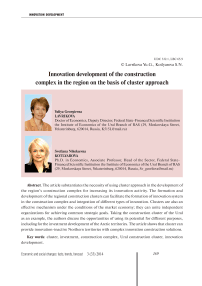Innovation development of the construction complex in the region on the basis of cluster approach
Автор: Lavrikova Yuliya Georgievna, Kotlyarova Svetlana Nikolaevna
Журнал: Economic and Social Changes: Facts, Trends, Forecast @volnc-esc-en
Рубрика: Innovation development
Статья в выпуске: 3 (33) т.7, 2014 года.
Бесплатный доступ
The article substantiates the necessity of using cluster approach in the development of the region’s construction complex for increasing its innovation activity. The formation and development of the regional construction clusters can facilitate the formation of innovation system in the construction complex and integration of different types of innovation. Clusters are also an effective mechanism under the conditions of the market economy; they can unite independent organizations for achieving common strategic goals. Taking the construction cluster of the Ural as an example, the authors discuss the opportunities of using its potential for different purposes, including for the investment development of the Arctic territories. The article shows that cluster can provide innovation-inactive Northern territories with complex innovation construction solutions.
Cluster, investment, construction complex, ural construction cluster, innovation development
Короткий адрес: https://sciup.org/147223595
IDR: 147223595 | УДК: 332.1 | DOI: 10.15838/esc/2014.3.33.13
Текст научной статьи Innovation development of the construction complex in the region on the basis of cluster approach
Innovation development and the leadership of innovation in the economy are a worldwide development trend of the policy in the science and technology sphere. However, the use of innovation in individual countries, regions and sectors is uneven. Usually it depends on the readiness of the state and region to organize innovation process, to manage it and regulate the relations arising in the sphere of innovation.
Innovation in construction plays a significant role in the country’s economic development, because the introduction of new technology for production of new materials and new products in different industries is connected with construction. Introduction of innovation in housing construction leads to the improvement of living conditions and increases people’s comfort. The construction of innovation buildings and structures influences the improvement of the social climate of social orientation (hospitals, schools, health centers, stadiums, etc.). The newly erected buildings, equipped with new facilities in some sectors, can be also considered as innovation.
From the viewpoint of technology, construction industry is the most conservative and slow to change. Its slow response to changes can be explained by several reasons. First, it is a long history of technological development of the construction complex, in the course of which a variety of materials and construction technology have already been tested and implemented. Second, it is the long lifetime of buildings and structures, within which the shortcomings of the applied technology can be identified. That is why builders are very cautious about choosing a new technology and new construction materials, because the responsibility for the result is theirs. Thirdly, it is the predominance of small firms, the low level of integration in the industry and excessive dependence on subcontractors. And finally, it is the lack of access to information about new products, materials and technology.
The level of innovation development in Russia’s construction complex can be assessed only by the level of innovation activity of organizations that manufacture building materials, products and structures, i.e. by the type of economic activity “Production of other non-metal mineral products”; the construction materials industry belongs to this group. The data presented in figure 1 show that this sphere is characterized by the low level of innovation activity in comparison with other types of economic activity1.
The share of organizations that implement technological innovation is about 9% in the total number of enterprises that produce construction materials (tab. 1) .
The use of new construction materials has a high social significance and potential. The development and usage of new construction materials in the historical aspect is the basis for innovation processes in construction2.
Figure 1. Innovation activity of organizations by the types of economic activity
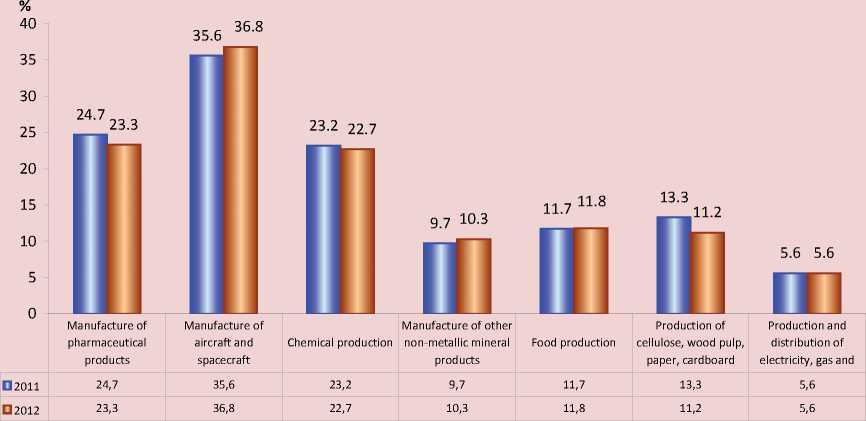
Table 1. Share of organizations that implement technological innovation in the total number of organizations, % *
Type of economic activity 2011 2012 Manufacture of pharmaceutical products 22.4 23.3 Manufacture of aircraft and spacecraft 33.6 36.1 Chemical production 21.1 20.9 Manufacture of other non-metallic mineral products 8.4 8.9 Food production 9.4 9.1 Production of cellulose, wood pulp, paper, cardboard 12.4 10.6 Production and distribution of electricity, gas and water 4.7 4.9 * Federal State Statistics Service. Official statistical information. Science, innovation and information society. Science and innovation. Available at: (accessed April 20, 2014).
The emergence and application of new materials leads to the increase in the energy efficiency of residential and industrial buildings, reduction in construction costs and operating costs, improvement of comfort of buildings and structures. For instance, brick, which replaced clay, increased the strength of buildings and allowed the number of floors to be increased. The emergence of monolithic construction technology allows the construction period to be reduced and provides for significant savings. Monolith also makes free space planning possible. The use of plastic window units provides a better insulation of the houses’ inhabitants from the influence of external factors.
The development and introduction of new materials provides constant impetus for new architectural solutions.
To ensure the compliance with international standards (Oslo Manual, a single survey program – EU CIS) the statistics distinguish several types of innovation: technological, marketing, organizational, management, etc. But innovation in construction is complex and its components should not be considered separately. Technological product innovation has value only if it reaches the consumer market. But the specifics of innovations in the construction industry consists in the fact that there is a necessity to go through a long chain of interrelated innovation solutions, and it is a complex and time-consuming process (fig. 2).
Administrative barriers and regulations hamper innovation breakthroughs in construction. The factors that impede the introduction of new technology in construction are as follows: absence or prolonged approval of technical norms and standards for new materials, constructions and technology; slow introduction of new standards in design solutions.
Another barrier for innovation is the corruption and conservatism of the author-
Figure 2. Stages and the main factors in the development
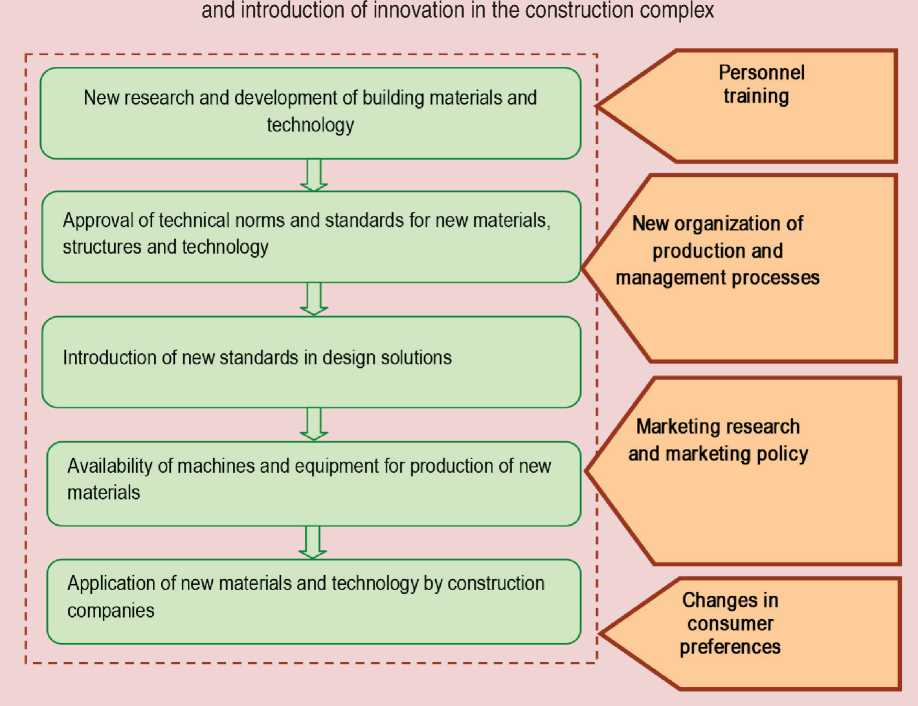
ities, who sometimes support large housebuilding plants that exhausted their potential. Besides, the apartment houses of bearing-wall construction that were built in large amounts in the Soviet period are no longer needed in big modern cities. The pace of introduction of innovation is slowed because of the low qualification of contractors and poor quality of construction materials, which are often produced in the process lines of the 1960s–1970s3.
Innovation solutions are not in full demand among designers and architects, though these people, who design their projects taking into consideration modern materials and innovation technology, should be a link between the major real estate developers and construction materials producers.
The absence of information interaction between construction materials manufacturers and executives responsible for decision-making in construction companies also impedes the introduction of innovation materials. Thus, the barriers to the introduction of new technology and materials in construction are not ideological, but rather administrative in nature.
Russia’s accession to the World Trade Organization further emphasized the need to promote innovation activities at construction enterprises. Experts predict the strengthening of foreign suppliers’ influence in the construction materials market, the increase in the import of construction materials at a lower price (from China and Turkey) and, consequently, the rise of competition in the Russian construction market4. It is necessary to form barriers to cheap but low-quality imported products and to support new innovation technology in construction on the state level.
The formation of innovation system in the construction industry and integration of different types of innovation within the building complex can be facilitated through the formation and development of regional construction clusters . Because within the framework of the cluster it is possible to form a strong connection between its participants, to increase the share of competitive construction materials produced by local building enterprises by introducing innovation methods in the organization of production5.
At present, regional construction clusters have been formed and are actively functioning in three regions of the Russian Federation: in the Sverdlovsk Oblast (Ural Construction Cluster), the Saratov Oblast (Interregional Research and Production Cluster), the Vologda Oblast (International Cluster of Wooden House Building and Wood Processing). Each cluster was created for different purposes depending on the needs of the industry and the region. The Ural Construction Cluster seeks to improve the efficiency and competitiveness of the region’s construction complex, preservation of market positions and market expansion. The Saratov Interregional Research and Production Cluster states its goal as the formation of a machinebuilding complex for the introduction of innovation materials in construction in order to reduce the cost of square meter of housing. The formation of such a cluster in the sphere of construction technology will allow for overcoming the technological gap and it gives a new impulse to the development of the construction complex. The Vologda International Cluster is aimed at attracting foreign advanced technology to develop a new branch – wooden house construction. Industrial low-rise wooden house building and structural steel construction are developing within the construction cluster.
The Sverdlovsk Oblast has a huge construction and industrial potential and takes a key place in the Ural area. That is why the Ural Construction Cluster is primarily aimed at the development of markets for the products of its construction companies. The development of housing construction in the neighboring regions is accompanied by increased demand and deteriorating regional capacities for the production of construction materials6. In this situation, the Ural Construction Cluster finds the majority of market outlets to be promising, and first of all, the markets of the neighboring Yamalo-Nenets and Khanty-Mansi autonomous okrugs. However, it is possible to enter these markets only through the establishment of coordination between the Sverdlovsk Oblast, Yamalo-Nenets and Khanty-Mansi autonomous okrugs in the sphere of development and accommodation of the construction industry enterprises, implementation of housing programs and development of the transport and logistics infrastructure. Thus, the development of the Ural Construction Cluster will solve the problem of the optimal allocation and development of productive forces in the large region.
The development of northern territories acquires special importance in connection with the implementation of a large-scale program for socio-economic development in Russia’s Arctic zone. This program provides for the implementation of many projects in the Arctic: the establishment of global transport, energy, information and telecommunication systems. Total investment for 7 years should be 1793 billion rubles, including at the expense of the federal budget – 623.3 billion rubles. Thus, the investment vector in the Russian Federation is shifting from the southern regions (construction of facilities for the 2014 Olympics) to the Arctic and adjacent northern territories. Figure 3 shows that the greatest volumes of investments into priority investment projects are concentrated in the northern territories of the Urals7, and therefore the Ural Construction Cluster intends to launch the development of northern resource areas.
It is important that the bulk of investment in the northern territories means new
Figure 3. Volume of investment into priority investment projects, billion rubles
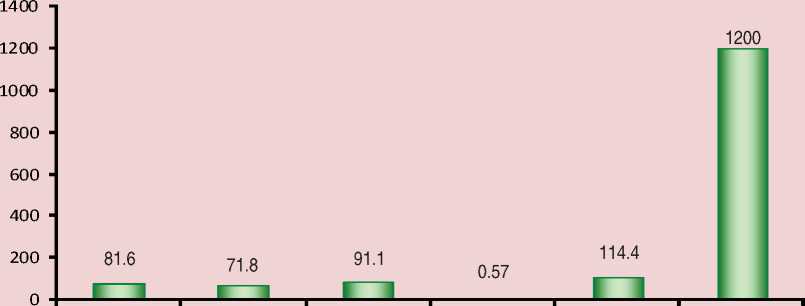
Chelyabinsk Kurgan Oblast Khanty-Mansi Yamalo-Nenets
Oblast
AO
AO
Tyumen Oblast Sverdlovsk Oblast
construction (industrial, transport, energy and residential facilities), taking into account the specifics of construction activities in the North and the design, engineering and technological solutions for Arctic conditions. These construction solutions should be comprehensive and complete; one organization or even several construction companies cannot offer or implement such a solution8.
Cluster is a mechanism that is efficient in the conditions of market economy and that is able to unite independent organizations for the achievement of a common strategic goal. In this regard, the involvement of cluster groups is an important condition for the investment development of the Arctic and fulfilling major tasks of its development.
Comparing the share of organizations that are implementing technological innovation in the RF regions, it can be noted that the Sverdlovsk Oblast has higher rates in this respect than the national average (fig. 4) . The innovation activity of organizations in Yamalo-Nenets and Khanty-Mansi autonomous okrugs is low. Thus, the northern territories with low innovation activity require complex innovation decisions, which can be provided by the enterprises of the Ural Construction Cluster.
The consumers of construction products are interested not just in obtaining construction materials of affordable quality and price, but, above all, in obtaining the final results in the form of construction objects – fast and quality housing, industrial and infrastructure buildings and facilities. Consequently, the market needs ready-made solutions. The Ural Construction Cluster is built on the principle that all of its participants ensure the final result.
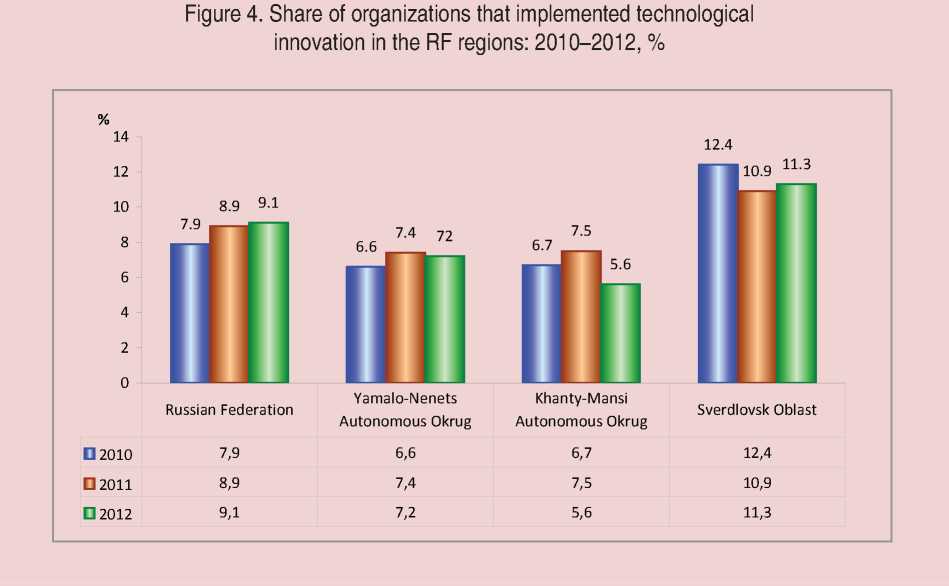
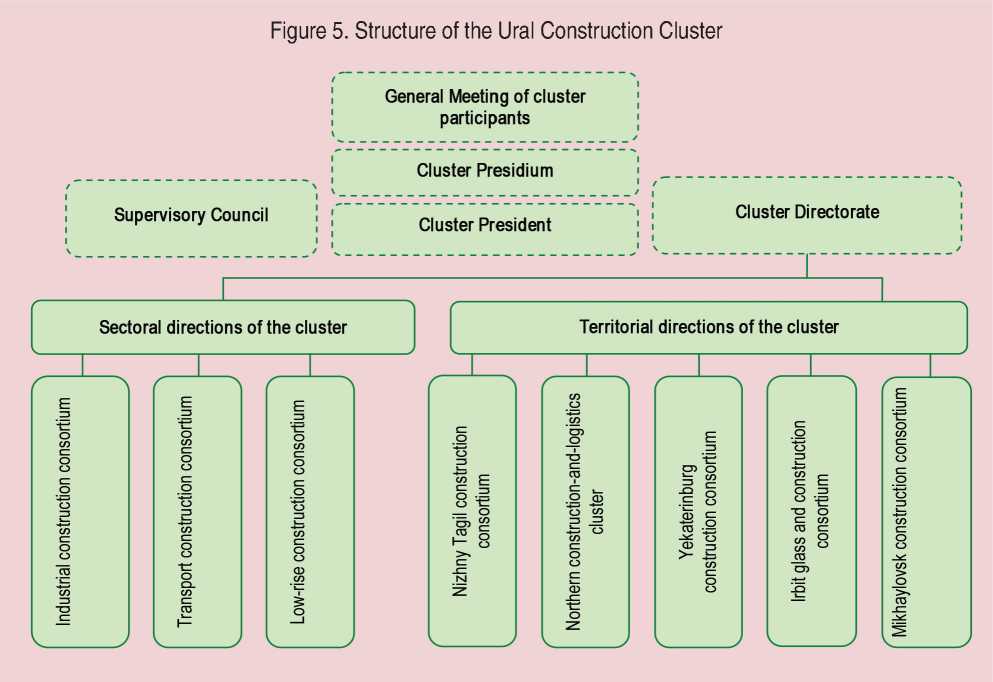
The Cluster includes designers, construction materials manufacturers, construction firms, educational and research institutes, engineering companies, representatives of federal and regional ministries, infrastructure organizations, banks and insurance companies9. Currently, this approach allows the companies of the cluster to perform the whole cycle of construction works in the volume up to 40 billion rubles per year with their own designers, general contractors, contractors, banks with ready credit lines. This is important for large-scale investment projects.
The creation of six consortia in different spheres of construction within the cluster (fig. 5) can be called an innovation organizational approach to the formation of the Ural Construction Cluster. The consortia have territorial and sectoral characteristics; each of them has its own features and creation purposes10.
The transport construction consortium has united more than 40 companies of transport construction, with work experience of more than 20 years, three institutes, construction materials plants, a subsidiary of a federal bank and an insurance company. With such a structure, the consortium can participate in electronic trading and competitions, involving the largest and most expensive orders. The objectives of the transport consortium are as follows: the construction of railways and motor roads of any complexity with full infrastructure.
The main goal of the industrial construction consortium is to build large industrial facilities of metallurgy, chemical industry, construction industry, mechanic and power engineering of any complexity with full infrastructure. Consortium enterprises participated in the federal programs for preparation for the APEC-2012 Summit in Vladivostok and the 2014 Winter Olympic Games in Sochi. The consortium includes institutions such as Uralgipromez and UralNIIAS.
The Yekaterinburg and Nizhny Tagil consortia are organized on a territorial basis and include construction industry enterprises and construction companies, municipal institutions, universities and banks. An obligatory condition of work is to implement any of the objects as a General Contractor. It is the prerogative of the “leader” of the consortium in this type of work, who by its own forces is able to perform up to 40% of the works on the given object. Prerequisites for the formation of these consortia are as follows: the implementation of a number of large investment projects in the field of construction in the cities; the large number of enterprises producing construction products; the availability of specialized educational institutions; the need for timely satisfaction of the needs of the territory in modern construction materials, products and structures for the implementation of housing programs or large investment projects.
The objective of the Mikhaylovsk and the Irbit consortiums is to develop the production of modern construction materials based on effective cooperation between enterprises with the aim of reducing costs, and also due to the necessity to meet the demand in construction materials with the expected increase in housing construction. A common infrastructure of networks and roads will be built; staffing issues and social problems in these two settlements will be addressed.
The low-rise construction consortium comprises the developers of cottage settlements and intends to cooperate with the authorities on the issues of provision of low-rise residential settlements with roads and engineering infrastructure.
The Northern construction-and-logistics cluster sees its main task in uniting the construction materials manufacturers that are located primarily in Nizhny Tagil, Krasnoturyinsk, Severouralsk, Serov and other northern territories of the Sverdlovsk Oblast, for the purpose of establishing productions in the northern regions of the Ural Federal District, especially in the Khanty-Mansi and Yamalo-Nenets autonomous okrugs. The Sverdlovsk Oblast has traditionally been a supplier of construction materials for these areas, and for the Tyumen Oblast as well. But now construction went far to the north and even beyond the Arctic circle. The north of the Sverdlovsk Oblast, Khanty-Mansi and
Yamalo-Nenets autonomous okrugs are industrial construction zones, since they are rapidly developing industrial regions. Implementation of large investment projects will increase the demand for building materials, including those required in housing construction.
Thus, the main purpose of creating such sectoral and territorial associations is to organize modern innovation productions of energy and resource saving construction materials, products and structures, and to enhance the competitiveness of local producers of construction materials. The establishment of the Ural Construction Cluster will make it possible to increase the volumes of deliveries of construction materials in the regions of the Ural Federal District. And in the future it will not only reduce construction costs, but also expand the market of innovation construction materials produced in the region.
Innovation development of the construction complex is possible on the basis of the comprehensive understanding of innovation as a set of technological, organizational, marketing and other types of innovation, which at present should be implemented on the basis of the cluster model of development.
Sited works
Innovation in the Construction Cluster: Obstacles and Prospects. Available at: (accessed January 02, 2014).
Kotlyarova S.N. Innovation Barriers and Perspectives of the Industrial Markets Development on the Example of Construction Industryю Economy of the Region , 2010, no.3, pp. 251-254.
Lavrikova Yu.G. The Cluster Approach in the Development of the Northern and Arctic territories. The North and the Market: Formation of Economic Order , 2014, no.6(43), pp. 71-74.
-
5. Loshchenko A.L., Kopsha S.P., Bikbau M.Ya. Construction-Industrial Cluster – Advanced Technology and Machinery for Construction. Technology of Concrete , 2013, no.8.
-
6. The Ministry of Regional Development of the Russian Federation . Available at: http://www. minregion.ru/Priorit_invest (accessed October 20, 2013).
-
7. After accession to the WTO the Russian Construction Market is Expecting Changes . Available at: (accessed January 20, 2014).
-
8. Stupin I. The Enemies of Construction Innovation. Expert , 2007, no.27(568).
-
9. Federal State Statistics Service. Official Statistical Information . Science, Innovation and Information Society. Science and Innovation. Available at: http://www.gks.ru (accessed April 20, 2014).
-
10. Yamshchikova I.V., Kudryavtseva V.A. Cluster Initiative as a Way of Innovation Development of the Region’s Construction Materials Industry. Polzunov Bulletin , 2012, no.4, pp. 127-131.
Список литературы Innovation development of the construction complex in the region on the basis of cluster approach
- Innovatsii v stroitel’nom klastere: bar’ery i perspektivy . Available at: http://www.inno-expert.ru/consulting/building (accessed January 02, 2014).
- Lavrikova Yu.G., Kotlyarova S.N., Chumerin Yu.N., Devyatykh Ya.Yu. Kontseptsiya i praktika formirovaniya Ural’skogo stroitel’nogo klastera . Yekaterinburg: Institut ekonomiki UrO RAN, 2013. 142 p.
- Kotlyarova S.N. Innovatsionnye bar’ery i perspektivy razvitiya otraslevykh rynkov na primere stroitel’noi otrasli Ekonomika regiona , 2010, no.3, pp. 251-254.
- Lavrikova Yu.G. Klasternyi podkhod v osvoenii severnykh i arkticheskikh territorii . SEVER I RYNOK: formirovanie ekonomicheskogo poryadka , 2014, no.6(43), pp. 71-74.
- Loshchenko A.L., Kopsha S.P., Bikbau M.Ya. Stroitel’no-industrial’nyi klaster -peredovye tekhnologii i mashinostroenie dlya stroitel’stva . Tekhnologiya betonov , 2013, no.8.
- Ministerstvo regional’nogo razvitiya Rossiiskoi Federatsii . Available at: http://www.minregion.ru/Priorit_invest (accessed October 20, 2013).
- Posle vstupleniya v VTO rossiiskii stroitel’nyi rynok ozhidayut peremeny . Available at: http://www.interfax.ru/realty/realtyinf.asp?sec=1457&id=261655 (accessed January 20, 2014).
- Stupin I. Vragi stroitel’nykh innovatsii . Ekspert , 2007, no.27(568).
- Federal’naya sluzhba gosudarstvennoi statistiki. Ofitsial’naya statisticheskaya informatsiya . Nauka, innovatsii i informatsionnoe obshchestvo. Nauka i innovatsii . Available at: http://www.gks.ru (accessed April 20, 2014).
- Yamshchikova I.V., Kudryavtseva V.A. Klasternaya initsiativa kak put’ innovatsionnogo razvitiya promyshlennosti stroitel’nykh materialov regiona . Polzunovskii vestnik , 2012, no.4, pp. 127-131.

